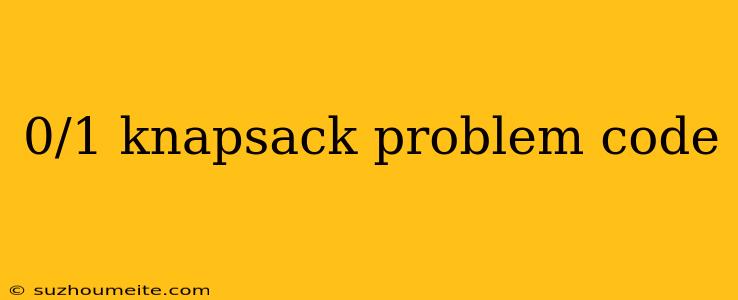0/1 Knapsack Problem: A Comprehensive Guide with Code
Introduction
The 0/1 knapsack problem is a classic problem in computer science and operations research that involves finding the optimal way to pack a set of items of different weights and values into a knapsack of limited capacity. In this article, we will explore the 0/1 knapsack problem, its variations, and provide a code implementation in Python.
Problem Statement
Given a set of items, each with a weight w_i and a value v_i, and a knapsack with a capacity W, determine the subset of items to include in the knapsack to maximize the total value while not exceeding the knapsack capacity.
0/1 Knapsack Problem Variations
There are several variations of the 0/1 knapsack problem, including:
- 0/1 Knapsack Problem: Each item can be included or excluded from the knapsack, but not fractionally included.
- Unbounded Knapsack Problem: Each item can be included multiple times in the knapsack.
- Bounded Knapsack Problem: Each item has a limited number of copies available.
Dynamic Programming Solution
The 0/1 knapsack problem can be solved using dynamic programming. The idea is to build a table dp where dp[i][w] represents the maximum value that can be obtained with a knapsack capacity w and considering the first i items.
Here is the Python code implementation:
def knapsack(weights, values, capacity):
n = len(weights)
dp = [[0 for _ in range(capacity + 1)] for _ in range(n + 1)]
for i in range(n + 1):
for w in range(capacity + 1):
if i == 0 or w == 0:
dp[i][w] = 0
elif weights[i - 1] <= w:
dp[i][w] = max(values[i - 1] + dp[i - 1][w - weights[i - 1]], dp[i - 1][w])
else:
dp[i][w] = dp[i - 1][w]
return dp[n][capacity]
# Example usage
weights = [2, 3, 5, 7]
values = [10, 20, 30, 40]
capacity = 10
max_value = knapsack(weights, values, capacity)
print("Maximum value:", max_value)
Time and Space Complexity
The time complexity of the dynamic programming solution is O(nW), where n is the number of items and W is the knapsack capacity. The space complexity is O(nW) as well.
Conclusion
The 0/1 knapsack problem is a fundamental problem in computer science and operations research that has many applications in real-world scenarios. The dynamic programming solution provides an efficient way to solve the problem, and the code implementation in Python is straightforward to understand and implement.
